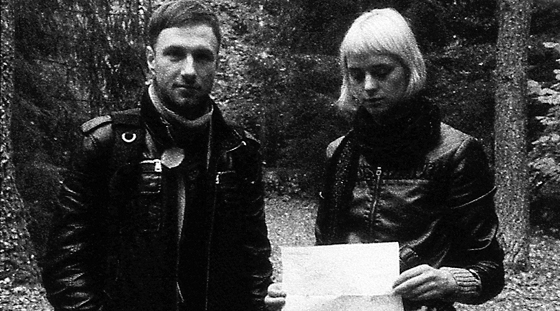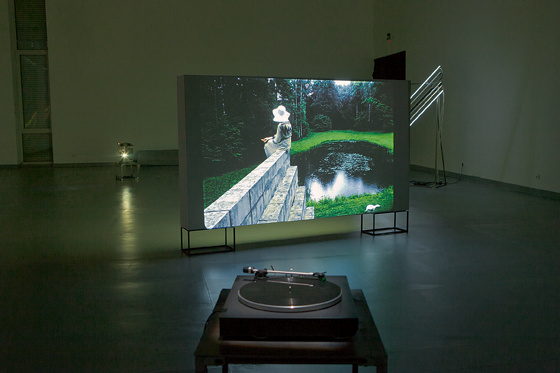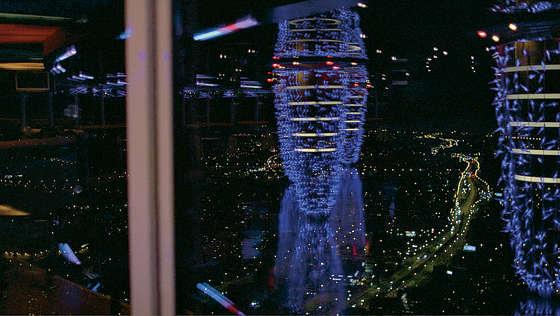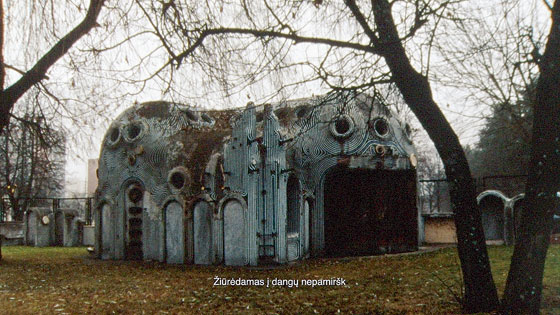|
|
| Nostalgia for dreams Eglė Juocevičiūtė, Art Critic, Curator Neringa Černiauskaitė, Ugnius Gelguda. Now More Than Ever 22.06.–12.08.2012. Contemporary Art Centre, Vilnius | |
| It was widely believed in the 17th century that nostalgia – longing for home – is a treatable medical condition. Doctors in Switzerland believed that Swiss soldiers suffering from nostalgia (which showed in the form of pain in the heart, dizziness, nausea and other symptoms) may be helped by means of opium, leeches and returning home to the Alps. Unfortunately, such means of treatment didn’t have a long-term effect. Doctors were completely unable find a cause of illness in the bodies of the ailing, and it gradually turned into a problem for philosophers and poets – from being a bodily illness it transformed into an emotional weakness and inducement to philosphising. Philosophers and poets (those in exile and other) created “houses” of dreams in their minds – places, spaces and systems of logic where they felt comfortable. At the end of the 19th century when nations were unifying, nostalgia became the main instrument of patriotism and nationalism for nations which had previously been enslaved. Meanwhile, a person who felt nostalgia was considered to be weak and unable to proceed forward in the USA, which had been established on the basis of emigrants and business as opposed to national pride. In the 20th century, all around the world nostalgia for the past became irrelevant, as the driving force at the time was a belief in technological innovation (modernity), progress and the bright future. Viewed from a contemporary standpoint, belief in progress and the creation of modern cities and countries resembles a universal and global fantasy, a made-up place and a logical system whose creators have been feeling nostalgia, this time in the form of a longing for a modern home. | |
 Ugnius Gelguda and Neringa Černiauskaitė. 2012 Photo from the private archive of the artists | |
| The history of nostalgia and ways it is manifested has been analysed from all points of view in Svetlana Boym’s book The Future of Nostalgia. She claims that the catalyst for nostalgia is a certain period of time as opposed to a certain place, and she distinguishes two tendencies in the manifestation of nostalgia, namely, a “restorative nostalgia” and a “reflective nostalgia”. The former focuses on the past as a snapshot, not as a prolonged period. On the other hand, reflective nostalgia relishes the flow of historic and personal time, the fragments and texture of time. Restorative nostalgia takes itself very seriously and is exhibited in the form of national memory, whilst reflective nostalgia may be ironic, witty, controversial, and may exhibit itself via social and cultural memory. The former creates symbols and rituals of the native land and tends to create space for time, whilst the latter highly appreciates the differences and distance between periods of time, and creates time for spaces as well. Reflective nostalgia seeks for unused opportunities in the past. If we keep that in mind, it is obvious that an ever increasing tendency for historicism and also a rise in nostalgia has been characteristic of contemporary art over the past decade. Perhaps at least partly this is linked to a general process of using ecology as a means of rectifying the consequences of progress and modern technologies by an application of the philosphy of DIY. However, while growing vegetables and making cosmetics at home, we still enjoy 50 year old photo cameras, video cameras, gramophones and projectors which were symbols of modernism at the time when they were created. While ever newer devices slide off the conveyor belt, people gradually approach the future already dreamt of. Looking at the people of the 20th century from the future and a position of knowing, we may only smile tolerantly about their naivety, admire their belief and envy their dreams about a future which didn’t entail an apocalypse. This is the reason why artists spend their time in archives, rake over attics of their grandparents, film birthdays of their children with 8 mm cameras (just like their grandparents did on the birthdays of their parents) and contrive versions of their own memories. The intoxicating future of technical equipment romantics should have become our romantic present, yet the conveyor belt somehow stopped at some point, leaving us to struggle with our present which is not at all intoxicating and, as stated by Boym, which leaves no room for dreaming. | |
 Neringa Černiauskaitė, Ugnius Gelguda. Now More Than Ever. View from the exhibiton. 2012 Publicity photos Courtesy of the artists | |
| The previous passage was an attempt to define my vision of the condition of Neringa Černiauskaitė and Ugņus Gelguda at the time when they created the exhibition Now even more than ever which constituted a part of the exhibition series Lithuanian Art: 18 Exhibitions at the Contemporary Art Centre of Vilnius. The exhibition comprised three projects – Atspindžių girios kronikos (‘Reflection Wood Chronicles’) (digitalised 16 mm film, 7’15, 2011; vinyl record, 7’05), Dabar labiau nei bet kada (‘Now More Than Ever’) (digitalised 16 mm film 8’27, 2011; 7 silver bromide prints, 12x17, 2011; one 35 mm slide projection) and Aukščiausiame taške (‘In the Highest Point’) (video film, full HD, 60‘2, 2011; 16 mm film, 4’47, 2011; neon object). As stated by the authors on the first page of the book about the exhibition, the last mentioned is the outcome of a collision of spaces, history and consciousness. However, reflecting on the exhibition from Boym’s point of view allowed us to identify it as a wonderful example of reflective nostalgia which complements Boym’s description. The main character in all three projects is a certain era, or a period of time – while on the odd occasion it is even possible to establish quite clearly that it is the Soviet period, in other cases certainty is lacking in the matter. The importance of the dimension of time and the diversity of understandings of time is reflected in the title of the exhibition, which has been taken from one of the projects – Now More Than Ever obviously focuses on “now”, yet “ever” is also of great importance, thus pointing towards the infinity of time that surrounds the present. “More than ever” is an evaluation of the present, conducted by means of addressing memories and exploring all the rememberable fragments of the infinite surrounding time. The projects have been created from fragments of collective and individual memories (experienced, found out, imagined), and joined with the ties of cultural and personal association; likewise, the separate art works have been united into a single exhibition. One feature common to the art works is the search for a specific fragment of time – imagining the future and alternative time which changed poeple’s living environment and their destinies. However, as typical of reflective nostalgia, the fragments of memories have not been joined into a single storyline, they are contradictory, and they don’t clarify the instances where Neringa and Ugņus speak about dreams about the future and alternative dreams, and where they are dreaming themselves. There are almost ten soundtracks in the exhibition, each of them presenting an alternative version of events. Reflection Wood Chronicles – a film projected on a temporary partition wall – recreates an artistically romantic stroll of a woman in the woods with fragments of futuristic wrecks in the background. The woman wears a hat and a white dress with dark geometric ornaments and pleats downwards from the waist, she is accompanied by a white greyhound resembling one who has stepped out of a Renaissance painting. She sits down for a while and smokes a cigarette, then stands in the doorway with the hat in her hands, her hair piled up and slightly messy. This character has been formed by combining many nostalgic signs of the epoch created by art and cinema: the dog brings to mind the British aristocracy, the dress and the hat are reminders of both the Impressionists and French films of the 1970s (the latter probably due to the cigarette), whilst the rain and the silhouette of the woman in the door opening are reminiscent of the Russian Empire dramas romanticised in feature films. All together it calls up a nostalgia for an aristocratic elegance which seems exotic in the context of Lithuanian cultural traditions. | |
 Neringa Černiauskaitė, Ugnius Gelguda. Now More Than Ever. View from the exhibiton. 2012 Publicity photos Courtesy of the artists | |
| The space where the woman walks around is a character in its own right. In fact, it is the Park of Europe – the contemporary open-air art museum not far away from Vilnius which, at the initiative of Gintaras Karosas, was created in 1991 and is still functioning successfully. Sculptures created by Sol LeWitt, Magdalena Abakanowicz, Elena Urbaitis and Aleš Veselý have been exposed to the Lithuanian rain, and have not been subjected to any cleaning (at least not noticeably) for two decades already. In the course of creation of the art works, the artists were aware of and tried to exploit the fact that the works were destined for darkening, rusting, becoming overgrown and disintegrating over time. In the absence of an explanation that they are art works, they might easily be perceived as the vestiges of guests from outer space. For the purposes of the film, Neringa and Ugņus have chosen the most architectonic (ones which can be entered, or where you can go up a staircase) exhibits of the Park of Europe which, due to the loss of their aura as art works (because the woman doesn’t look at them), turn into elements or remains of awkward buildings in the elegantly wild environment. Ruins most probably are the best catalyst for nostalgia. However, what we see here are the ruins of an alternative time or future, not of the glorified past. The use of the word “chronicles” in the title of the art work suggests that there was the intention to leave an impression of a documentary film from the past, now found in the archives of “alternative time”, thus urging for it to be perceived with artistic nostalgia. So we see in the film a future which has been imagined in the 1970s, created, then collapsed, and only afterwards documented and placed in an archive. A separate character in the film is its soundtrack – a record played featuring Henry Purcell’s aria Music for a While (1692), as composed for John Dryden’s and Nathaniel Lee’s tragedy Oedipus and performed by Viktor Gerasimov. The role of this crystal-clear Baroque musical composition is to calm down the angry Fury, whose assignment is to punish those who had killed their fathers (like Oedipus). The aria is as long as the film, and the record keeps playing continuously, but, given the fact that it comprises more silence than music, and that its cycle doesn’t coincide with repetition cycles in the film, the sound of the aria appears and becomes a heartfelt film sound-track at crucially different moments of the film, thus manipulating with the perception of the image. A concise, seven minute long conciliation takes place at the moment when the viewer sees the woman going for a walk in the film; in a way, it serves as a substitute for day-dreams for those who have fallen out of the habit of dreaming. | |
 Neringa Černiauskaitė, Ugnius Gelguda. In the Highest Point. Still from full HD video. 2011 Publicity photos Courtesy of the artists | |
| Now More Than Ever and In the Highest Point deploy more specific historic events. The first work is dedicated to memories of spring 1972 – a culmination of the hippy movement in Soviet Lithuania. On 15 May, 1972, at Laisvės alėja (Freedom Alley) in Kaunas, Romas Kalanta committed self-incineration, leaving a suicide note with the text “For freedom”. Information about the incident spread immediately and demonstrations of an unbelievably large scale began, and went on for four days in the largest cities. The film shows us an actor in front of an empty auditorium reading the recollections of an accidental witness to a demonstration of hippies in the streets of the city. The actor also watches and shows to the audience documentation of these events in slide projections. However, this documentation is of lesser importance than the narrator. Simplicity is characteristic of the narration, it reveals specific details of the life of a Soviet student – bottles of cheap wine being consumed while sitting on a bench in a park, dormitories with strict rules with regard to behaviour and outer appearance, the incredible significance assigned to music records and sunglasses. Only one single dramatic incident happens to the narrator during the demonstration, namely, a bottle of red wine he is carrying in his pocket shatters. If the narration were just a little bit more heartfelt, this incident could symbolise “bleeding for freedom”, or something similar. However, it is actually absolutely casual and soon forgotten, leaving no room for an instinctive “turning into a symbol”. The narration doesn’t involve any socially political evaluation of hippies, their demonstration and its significance in the history of Lithuania. Instead, it is a mere summary of events experienced by the witness during his university years, when he had a plenty of spare time but it was not clear how to spend it. In the fatalistic rendition hope glimmers in the last sentence, yet is quickly erased again: “I recall that spring now more than ever – that’s when I acquired my first sunglasses”. The film is complemented by seven photographs – a documentation of the filming of the narration. The spring of 1972 in Lithuania was a faint echo of the summer of 1968 in the West. The significance of the latter year has gone far beyond that of a certain period of time, it is also a social and cultural concept, whilst the events of 1972 are recalled by very few people and they aren’t of any iconic significance. The documentation of filming the narration is a parody of the process whereby an icon is created: “Take a look, this is a man who was in the demonstration and shares his memories about it.” A slide showing documentation of the disorder–inflicted damage – a photograph depicting a damaged shop-window which has been “repaired” with a diamond-shaped piece of paper – is projected in dramatic manner opposite the TV set on a special sheet which leaves a transparent shadow on the wall. One can’t find any signs of drama in the photograph, yet the white diamond shape placed almost in the centre of the photograph looks to be very symbolic, although it is unclear what meaning it bears. I believe this is an ironic reference to the mechanisms for creating an icon. With the help of memories and restorative nostalgia, the specific timeframe and events of 1972 could have become the cornerstone of patriotism, yet they failed to do so. Neringa’s and Ugņu’s reflective nostalgia explains the reasons for such a failure by demonstrating the casual contradictariness of the era. | |
 Neringa Černiauskaitė, Ugnius Gelguda. In the Highest Point. 16 mm film. Film still. 4’47. 2011 Publicity photos Courtesy of the artists | |
| In the most impressive and decorative part of the exhibition In the Highest Point we see a colourful, horizontally-moving futuristic vision of a city at night which occupies almost the complete surface of a wall, namely, images of plastic futuristic buildings which have been filmed with a 16 mm camera and which are being projected onto a partition wall with a film projector. It is accompanied by a large neon object in shape of a stylised comet. All of this appears immediately once a visitor has entered the dark exhibition hall. In the Highest Point commemorates the Karoliniškės district of Vilnius, a monument to the dreams of the 1980s about conquering outer space. The district was built around the Kosmonautų prospektas (Astronaut Avenue), where the department stores Merkurijus, Saturnas and Kometa were located, along with a TV tower pointing towards the sky and a “cosmic” kindergarten. Hence the futuristic vision of a city at night consists of scenes filmed through the window of a restaurant situated in the TV tower. The film has been shot at night, which is the reason for the presence of bright, flickering neon lights (colours change horizontally, thus emphasising the effect of movement), and the silhouettes of thrusting columns wrapped in strings of lights reflected in the window glass. The background for these lights consists of scenes of the city, namely, street lights dotting out curved boulevards which form unexplored galaxies. So – welcome to the bar of the space ship, where you’re sitting whilst on your trip to your summer cottage on Mars. A hissing and crackling projection of the 16 mm film shows scenes of the “cosmic” kindergarten. The “cosmic” effect is implied by plastic, almost biomorph shapes of buildings and playground equipment, complemented by a mosaic of small stones and tiles which reflects these silhouettes. The key element depicted is an outhouse with many round openings in the domed roof. When the camera approaches the dome and creeps inside, subtitles appear – it is an excerpt from the script in poetry of a film that was never made, Let the galaxies collide! by Tamara Levkova and Michail Kariukov (1959). The text reminds the visitor that stars – small bright spots in the sky – are the suns of other lands. Children attending the kindergarten have been provided with their own private heavens with an unseen galaxy. From here we peer upwards and probably meet the gaze directed downwards from the TV tower. The neon comet is a replica of the department store Kometa sign which presumably was one of the longest surviving among the cosmic accents of the Karoliniškės district. Six years ago it was still present to remind us of the noble mission of the district. The neon comet probably demonstrates most clearly how the dream of outer space was expressed – by means of stylised symbols, purely decoratively. Thinking it over, all the components – the huge projection (which at the start seemed almost abstract), the close-up of the mosaic of tiles and the excerpt of the text about distant galaxies resembling small glittering spots in the sky – unite and form a uniform assertion. Perhaps in order to inspire a large number of people with an unattainable dream it is necessary to stylise it, to make it visually attractive and easily recognised. The soundtracks and films utilised by Neringa and Ugņus in this exhibition, as well as the manner of their synchronous and asynchronous arrangement, form many meanings that encourage a search for explanations and deeper involvement. But this time the key area of my interest was their nostalgia for shattered dreams and lost opportunities: the documentation found in the archive of alternative time, the film (which wasn’t made) about conquering outer space (which didn’t happen), and the swiftly suppressed civil disturbances, which didn’t achieve any change and were forgotten. Each part of the exhibition is different due to the use of dissimilar, nostalgically stylish techniques (16 mm film, a slide projector, a gramophone) and different visual stylistics. Owing to the use of all available types of design, the spirit of each time period creates a unique style which when remembered brings forth a huge number of associations, thus letting nostalgia take off. Now, what is the style of your nostalgic dreams? Translator into English: Jānis Aniņš | |
| go back | |







